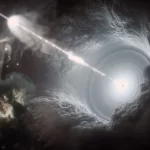Key Takeaways:
- Astronomers have recently uncovered enigmatic structures known as Odd Radio Circles (ORCs) in space, surpassing the size of the Milky Way.
- These ORCs, first spotted by the ASKAP radio telescope in Australia, present an astronomical puzzle due to their vast dimensions, potentially spanning a million light-years.
- Despite capturing attention, the origins of these ORCs remain a baffling mystery, with theories ranging from galactic shockwaves to exotic phenomena like wormhole throats.
- As of now, five ORCs have been observed, with the potential for six more awaiting discovery, deepening the enigma surrounding these cosmic anomalies.
- The implications of ORCs extend to theories of cataclysmic events like galaxy-spanning explosions and the energetic release of particles from powerful jets.
In a groundbreaking revelation, astronomers have unearthed a set of extraordinary cosmic structures known as Odd Radio Circles (ORCs). These enigmatic phenomena, first brought to light by the ASKAP radio telescope under the auspices of Australia’s CSIRO, have garnered attention for their colossal proportions, potentially dwarfing even the expansive scale of the Milky Way by encompassing diameters in the order of a million light-years. While five ORCs have been confirmed, there are prospects of discovering six more, further deepening the intrigue surrounding these cosmic enigmas. Despite their prominence, the origins of ORCs remain shrouded in mystery, with speculations ranging from galactic shockwaves to more exotic hypotheses such as wormhole throats.
A pivotal breakthrough in understanding ORCs occurred in March 2022, when the South African MeerKAT radio telescope captured detailed images of ORC1 (ORC J2103-6200). This marked an unprecedented level of intricacy in documenting an ORC, setting the stage for enhanced scientific inquiry. According to Bärbel Koribalski, a radio astronomer from the Australian Commonwealth Scientific and Industrial Research Organization, these structures bear a resemblance to soap bubbles or Fabergé eggs, with their outer circles boasting a diameter exceeding a million light-years, surpassing the Milky Way’s scale by an order of magnitude.
ORCs represent a recent and fascinating addition to the realm of astronomical sciences. Discovered over three years ago by astronomer Anna Kapinska with the aid of Australian radio telescopes, initial suspicions leaned towards calibration issues. However, their confirmed existence underscores the need for further investigations into their origins. These distinctive circles, with luminous edges, are exclusively observable within the radio spectrum. Notably, three out of the five known ORCs are adorned with cores corresponding to discernible galaxies, adding another layer of intrigue to their complex nature.
The implications of ORCs extend to the very fabric of galactic processes. One theory posits them as remnants of a cataclysmic explosion within galactic centers, possibly arising from the merging of colossal black holes. Another explanation suggests shockwaves originating from the birth of millions of stars. The third proposes the release of highly energetic particles into galaxies through powerful jets. While ORCs manifest as faint emission rings encircling galaxies hosting exceptionally active black holes, the reason behind their rarity remains an unsolved conundrum. Although they emerged roughly a billion years ago, their continuous study underscores the vast mysteries that still await unraveling.


